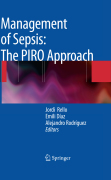
Sepsis is a very important public health problem. It is widely acknowledged that the severe inflammatory response syndrome/severe sepsis paradigm fails to stratify sepsis patients adequately. This book reviews in detail how sepsis should be managed on the basis of a novel approach to staging. The PIRO (predisposing factors, infection, response, organ dysfunction) model was first proposed at the start of the decade on a theoretical basis and has now been translated into a practical approach for use at the bedside. It is loosely based on theTNM staging system for cancers, with points being allocated to each of the four aforementioned key characteristics of the septic process. The proposed PIROframework facilitates evaluation of factors that are important in the pathogenesis of severe sepsis and in the development of treatment strategies. This book clearly explains the advantages of the PIRO approach in different settings and will be of value to all practitioners concerned with the management of sepsis. Documents the drawbacks of the traditional SIRS concept Examines in detail how sepsis should be managed on the basis of the new PIRO approach to sepsisstaging Explains the advantages of the PIRO approach in a variety of settingsWritten by leading experts INDICE: Immunoglobulins in sepsis. Immunity and sepsis. Coagulation disorders in sepsis. MODS, SOFA or PIRO? Real-time PCR in microbiology: >From diagnosis to characterization. Influence of serotype: A new challenge for vaccination. Role of organism: What have we learned from EPICII? VAP-PIRO. CAP-PIRO. Severe sepsis and antibiotics: Which is the best combination? Is PIRO the key to success? PIRO and sepsis: What does it mean for pharmacology? ARDS in Sepsis. Acute kidney injury and sepsis. Management of sepsis based on the PIRO concept.
- ISBN: 978-3-642-00478-0
- Editorial: Springer
- Encuadernacion: Cartoné
- Páginas: 260
- Fecha Publicación: 01/06/2009
- Nº Volúmenes: 1
- Idioma: Inglés
